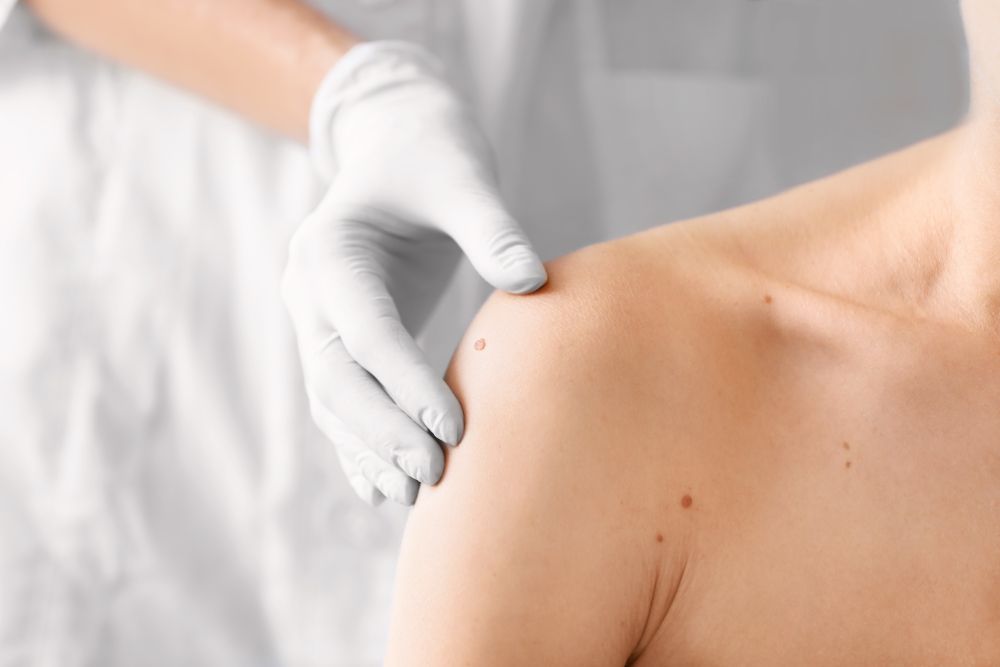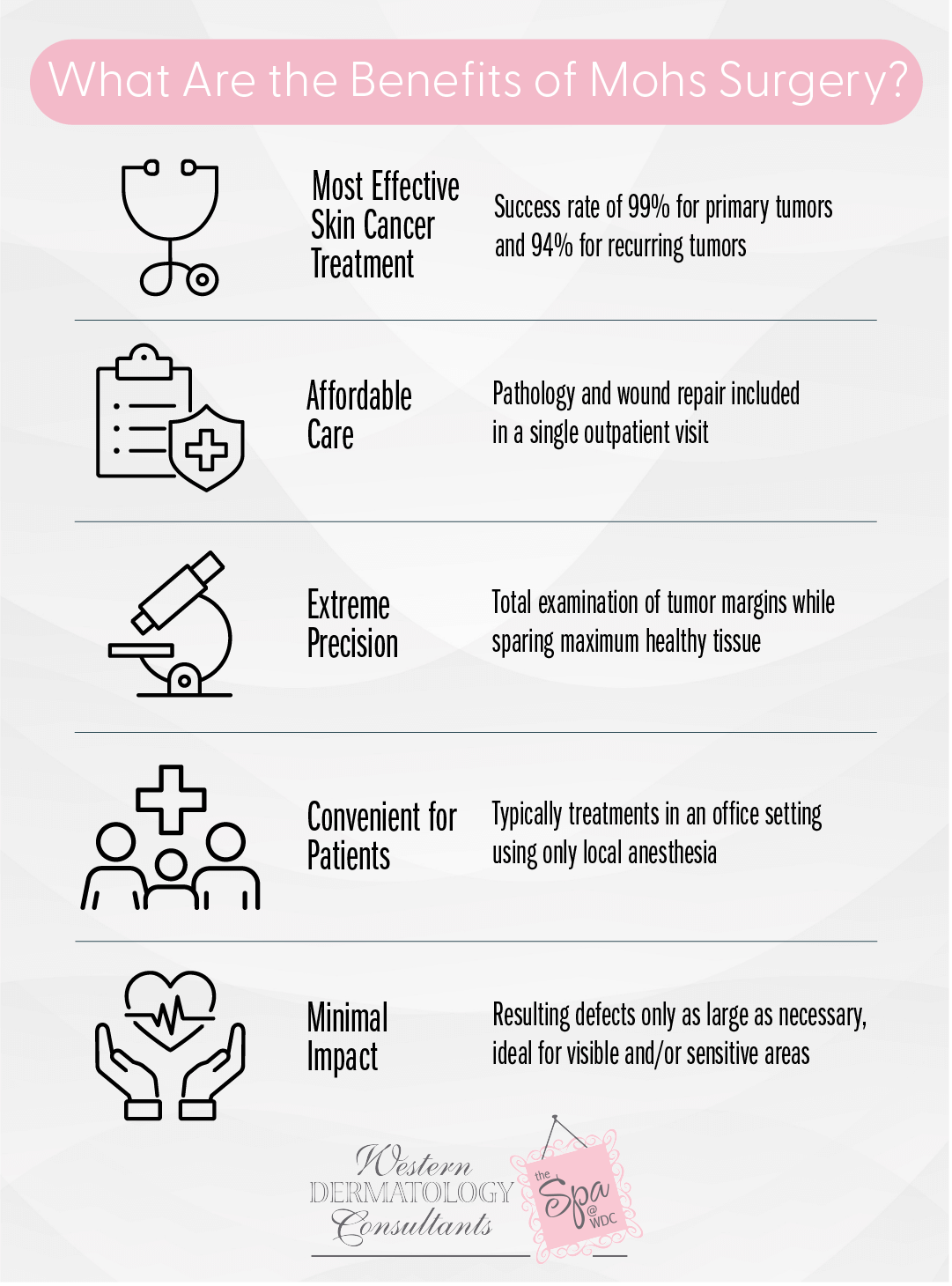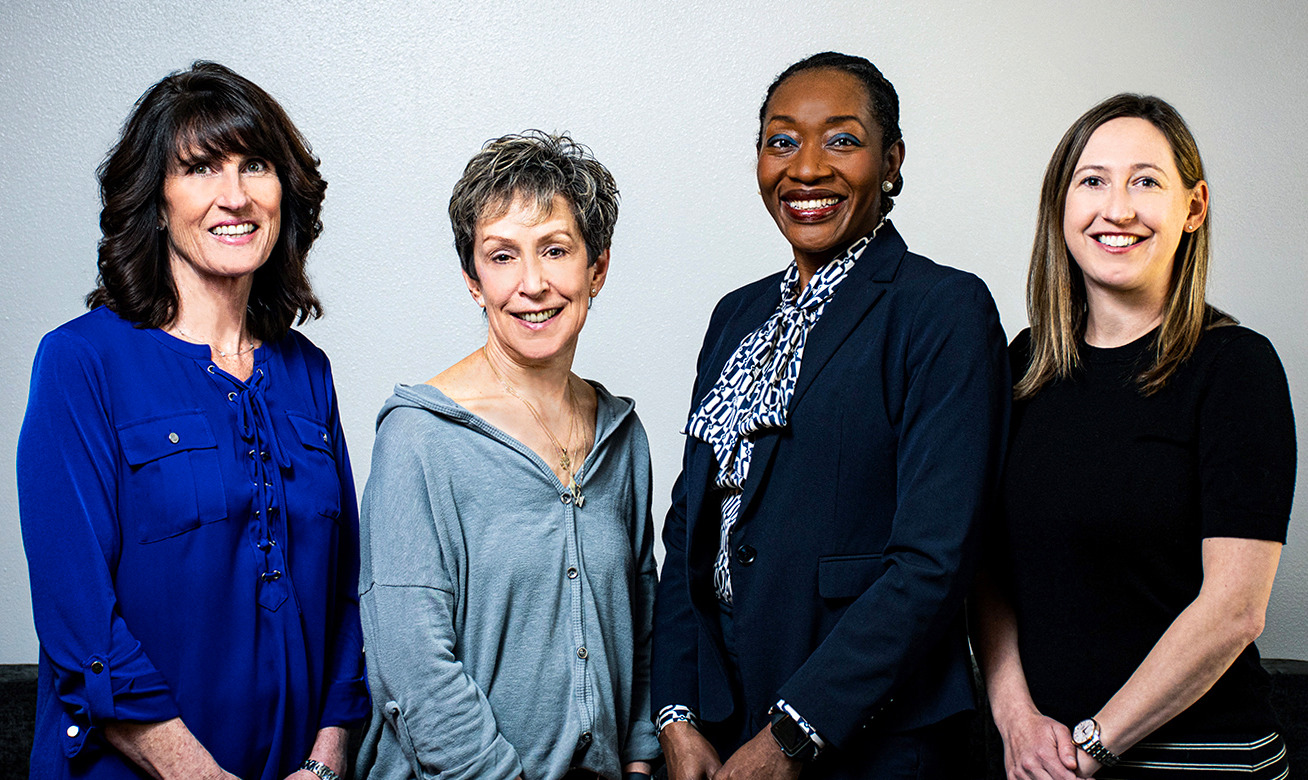- Home
- Treatments
- Mohs for Skin Cancer
Mohs Surgery

Modern, Effective Treatment for Skin Cancer in Albuquerque, NM
The best treatment for skin cancer depends on the type, location, and stage of the cancerous cells. Mohs surgery at Albuquerque’s Western Dermatology Consultants is used for basal cell carcinoma and squamous cell carcinoma because it’s a highly effective surgery that also maximizes cosmetic results. This makes the procedure particularly well-suited to skin cancers that develop on cosmetically or functionally significant areas, such as the face, head, and hands.
Mohs surgery, also known as chemosurgery, is ideal for highly visible areas because it is an extremely precise surgery that removes only the cancerous tissue and just enough beyond its margins to get rid of the malignant cells, thus preserving the maximum amount of surrounding unaffected skin tissue.

Contact Us
Learn more about the benefits of receiving Mohs surgery in Albuquerque, NM by calling Western Dermatology Consultants 505-855-9267 or requesting a free consultation online.
A dermatologist must receive special training to be qualified to perform Mohs surgery, as they perform the role of skin cancer surgeon in excision and wound closure, as well as pathologist in examining each layer of cancerous cells. Experienced surgeons can also close the wound to minimize cosmetic disruption.
Mohs Surgery Treatment Details
Surgical tumor removal has long been a treatment used by doctors to combat skin cancer, but Mohs micrographic surgery—first developed in the 1930s—is a particularly sophisticated and rigorous approach to treating the disease. Today, Mohs surgery holds a five-year cure rate of 94 to 99 percent, depending on the nature of the cancer being treated, and whether it is the first occurrence or a recurrence. It is the highest cure rate of any treatment for basal or squamous cell carcinomas.
Mohs surgery is a surgical excision that is performed in stages at a single visit, as each layer of cancerous tissue is removed one by one. Cancer cells are not strictly limited to visible tumors, and may extend into the surrounding tissue, which can lead to further health problems if they remain present but unseen after a tumor is removed.
Mohs surgery at Albuquerque’s Western Dermatology Consultants involves a dermatologist removing a very thin layer of surrounding tissue along with the tumor. The procedure is typically performed under local anesthesia on an outpatient basis, and could last up to several hours depending on the size of the area to be treated. This will be determined during a consultation.
Each layer of tissue is excised, specially prepared, then taken to the lab to be examined minutely under a microscope to check for signs of cancer while the patient waits. This testing stage is usually what takes the majority of time.
If any malignant cells are detected, another layer is taken and examined. Part of the Mohs surgery is to map every area that a sample is excised from, so that the dermatologist knows where to continue (and which areas to leave out) if a cancerous layer is found. This goes on until the dermatologist finds nothing but cancer-free tissue samples. These are known as clear margins.
With more traditional forms of surgery (such as local excision), only about 1 to 3 percent of a tumor’s margins are actually examined, leaving room for some cancerous cells to be left behind. Mohs surgery allows virtually all percent of the tumor’s margins to be examined, thereby greatly reducing the chance for some cancer cells to be missed.
Because the layers are so thin and the Mohs process is so meticulous, the wound left behind after the tumor removal is only as big as it needs to be, and the cure rates are the best of any widely accepted treatment strategy.

Discover the benefits of Mohs surgery at Albuquerque’s Western Dermatology Consultants, including its status as the most effective skin cancer treatment, its affordability, its precision, its convenience for patients, and its minimal impact on surrounding tissue.
Trust the Experts
Our board-certified dermatologists will take the time necessary to understand your skincare goals, and present you with an array of options for amazing skin.
Once the tumor and any other cancerous cells have been completely excised, there are a number of options for repairing the surgical wound. These include:
- Healing by second intention (allowing the wound to heal naturally)
- Primary closure (the use of stitches to close up the wound)
- Skin flap (using skin from an adjacent area to cover up the wound)
- Skin graft (taking skin from another area of the body, such as the thigh or behind the ear, to cover the wound)
Post-surgical checkups should also be scheduled to make sure recovery is going smoothly, and to proactively prevent or treat recurrences of the cancer. People who have been diagnosed with skin cancer are more likely (by as much as 50 percent) to have new tumors than those who have never had it. Typically, skin exams should occur at least once a year after surgery, or more often depending on the cancer’s recurrence rate and how aggressive it was.
If the area operated on was extensive or the procedure was complex, your dermatologist will temporarily close up the wound and explain the options available to you for reconstruction, if necessary or desired, and possibly refer you to another surgeon for reconstructive surgery.
There are other medical advantages to Mohs surgery. It is safe and very effective to be performed on tumors that do not have well-defined borders, or on those that may have recurred after receiving a different treatment—even if the cancerous area contains scar tissue or is large.
As noted earlier, delicate areas such as the eyelids, fingers and toes, and genitalia that have cancerous lesions to be removed may be treated with Mohs surgery.
Basal cell and squamous cell carcinoma patients can discuss Mohs surgery as an option with the Western Dermatology Associates team during a visit and consultation to determine whether the method represents the best option for them.
A Note on Melanoma
Basal cell and squamous cell carcinoma patients are more likely to be suitable candidates for Mohs surgery, as these non-melanoma forms of cancer are typically slower to spread and can be contained within a small location if they are caught early.
In some cases, Mohs can be used on melanoma, the most aggressive and deadly form of skin cancer, but Western Dermatology Consultants uses the advanced surgical technique only for treating basal and squamous cell carcinomas. If you have a melanoma diagnosis, know that you have several options available that our dermatologists can list and explain to you. The primary goal of any suggested treatment will be to preserve your health, followed by preserving your appearance as effectively as possible.
Contact Us
Call 505-855-9267 today to make your appointment or request a free consultation onlineand learn more about Mohs surgery at Albuquerque′s Western Dermatology Consultants.
More Than Mohs Surgery for Skin Cancer
Learn more about skin cancer treatment options, as well as the different types of skin cancer that can develop, from the team at Western Dermatology Consultants.
Note that there are also many skin conditions that can resemble skin cancer, but are actually benign and may be treatable. A diagnosis from a doctor is crucial to correctly identifying cancer and setting the best course of action.

